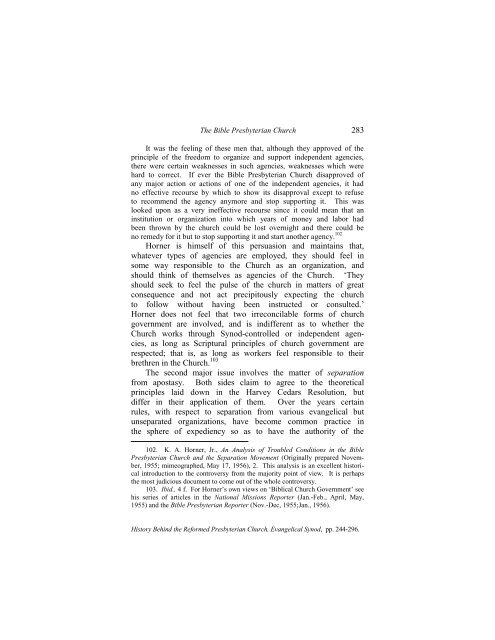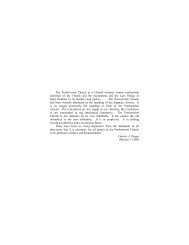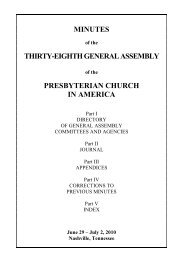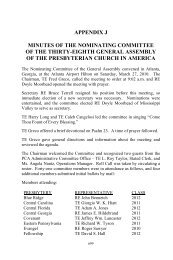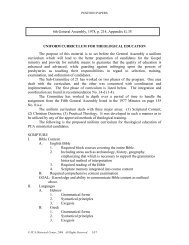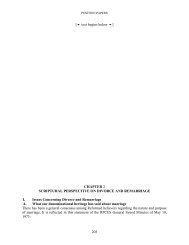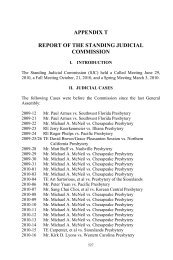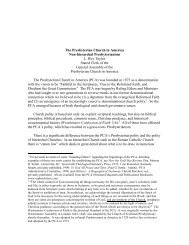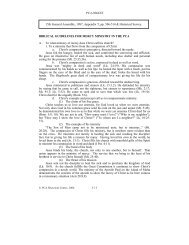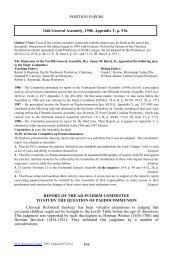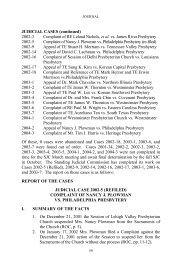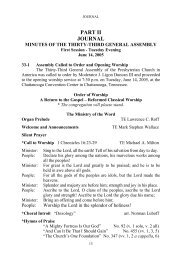Chapter 7: The Bible Presbyterian Church - PCA Historical Center
Chapter 7: The Bible Presbyterian Church - PCA Historical Center
Chapter 7: The Bible Presbyterian Church - PCA Historical Center
Create successful ePaper yourself
Turn your PDF publications into a flip-book with our unique Google optimized e-Paper software.
<strong>The</strong> <strong>Bible</strong> <strong>Presbyterian</strong> <strong>Church</strong> 283It was the feeling of these men that, although they approved of theprinciple of the freedom to organize and support independent agencies,there were certain weaknesses in such agencies, weaknesses which werehard to correct. If ever the <strong>Bible</strong> <strong>Presbyterian</strong> <strong>Church</strong> disapproved ofany major action or actions of one of the independent agencies, it hadno effective recourse by which to show its disapproval except to refuseto recommend the agency anymore and stop supporting it. This waslooked upon as a very ineffective recourse since it could mean that aninstitution or organization into which years of money and labor hadbeen thrown by the church could be lost overnight and there could beno remedy for it but to stop supporting it and start another agency. 102Horner is himself of this persuasion and maintains that,whatever types of agencies are employed, they should feel insome way responsible to the <strong>Church</strong> as an organization, andshould think of themselves as agencies of the <strong>Church</strong>. „<strong>The</strong>yshould seek to feel the pulse of the church in matters of greatconsequence and not act precipitously expecting the churchto follow without having been instructed or consulted.‟Horner does not feel that two irreconcilable forms of churchgovernment are involved, and is indifferent as to whether the<strong>Church</strong> works through Synod-controlled or independent agencies,as long as Scriptural principles of church government arerespected; that is, as long as workers feel responsible to theirbrethren in the <strong>Church</strong>. 103<strong>The</strong> second major issue involves the matter of separationfrom apostasy. Both sides claim to agree to the theoreticalprinciples laid down in the Harvey Cedars Resolution, butdiffer in their application of them. Over the years certainrules, with respect to separation from various evangelical butunseparated organizations, have become common practice inthe sphere of expediency so as to have the authority of the102. K. A. Horner, Jr., An Analysis of Troubled Conditions in the <strong>Bible</strong><strong>Presbyterian</strong> <strong>Church</strong> and the Separation Movement (Originally prepared November,1955; mimeographed, May 17, 1956), 2. This analysis is an excellent historicalintroduction to the controversy from the majority point of view. It is perhapsthe most judicious document to come out of the whole controversy.103. Ibid., 4 f. For Horner‟s own views on „Biblical <strong>Church</strong> Government‟ seehis series of articles in the National Missions Reporter (Jan.-Feb., April, May,1955) and the <strong>Bible</strong> <strong>Presbyterian</strong> Reporter (Nov.-Dec, 1955;Jan., 1956).History Behind the Reformed <strong>Presbyterian</strong> <strong>Church</strong>, Evangelical Synod, pp. 244-296.


